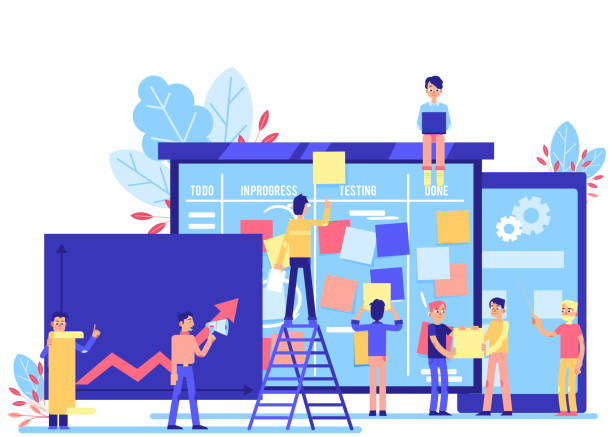Why Website Speed Is Crucially Important?
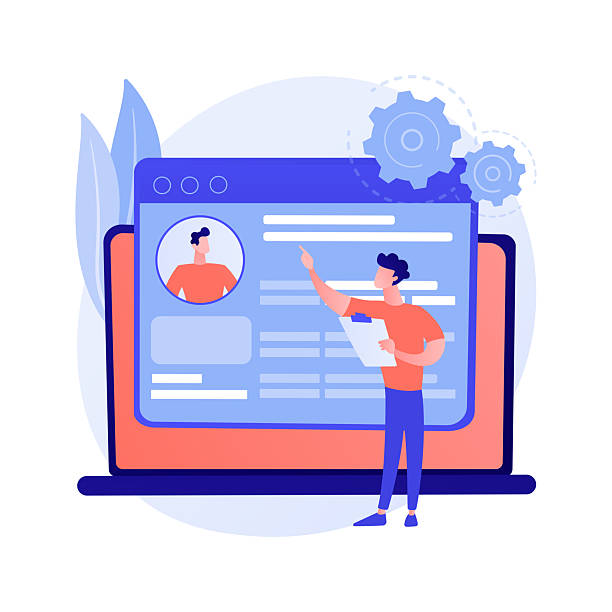
In today’s digital world, where speed is paramount, fast website design is no longer a luxury option, but an undeniable necessity.
Imagine a user visiting your website and encountering long loading times; statistics show that a significant percentage of these users will abandon the site before the page fully loads.
This is where the importance of #website_speed, #user_experience, and #search_engine_optimization (SEO) becomes evident.
Websites that load quickly not only significantly increase user satisfaction but also have a direct impact on their ranking in Google search results.
Google increasingly considers site loading speed as a key factor in its ranking algorithms.
This means that a slow website, even with excellent content, may lose its position in competition with faster sites.
Furthermore, site speed also affects the Conversion Rate.
Potential customers are more likely to complete purchase processes, registrations, or contact forms on a faster website.
A fast website design enhances your brand’s credibility and demonstrates your professionalism and attention to detail.
Thus, by optimizing site speed, you not only help increase traffic and improve SEO ranking but also directly impact your online business’s revenue and success.
It’s a plain truth that today’s users are impatient and expect to have information instantly.
Don’t have a corporate website yet and missing out on online opportunities? With professional corporate website design by Rasaweb,
✅ Double your business credibility
✅ Attract new customers
⚡ Free consultation for your corporate website!
Key Factors Affecting Your Website Speed
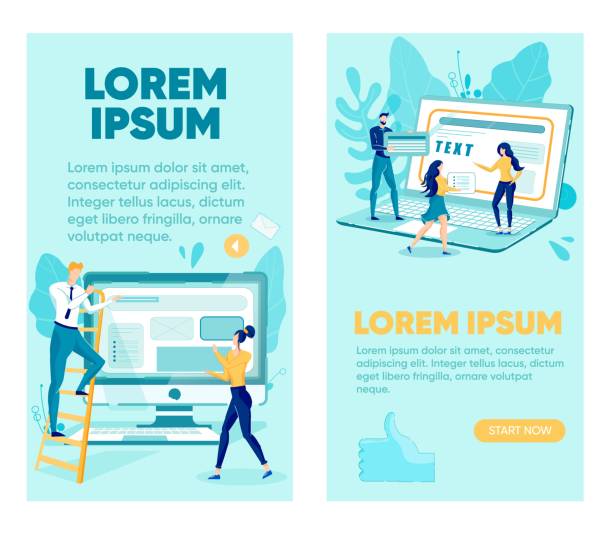
To achieve a fast website design, one must first identify the main factors affecting loading speed.
One of the most important factors is web hosting.
Choosing low-quality hosting with slow servers can nullify even the best design.
The type of hosting (shared, virtual private, dedicated) and the server’s geographical location relative to target users play a significant role in speed.
Another critical factor is website coding.
Disordered, heavy, and unoptimized HTML, CSS, and JavaScript codes can significantly increase loading times.
Using heavy frameworks and unnecessary JavaScript libraries also slows down the site.
The size and optimization of images and media are also common reasons for slow websites.
High-volume images without proper compression can add tens of megabytes to page size, making loading time-consuming.
Plugins and add-ons, especially in Content Management Systems like WordPress, if used excessively or unoptimized, can place a heavy load on the server and disrupt site performance.
Each new plugin adds extra code and new requests to the site.
Lack of Content Delivery Network (CDN) for faster content delivery to users worldwide, and improper caching implementation, are also factors contributing to slow speed.
All these factors interact in a chain, and a set of coordinated actions is required to have a fast and efficient website design.
Choosing the Right Hosting and CDN for Fast Loading
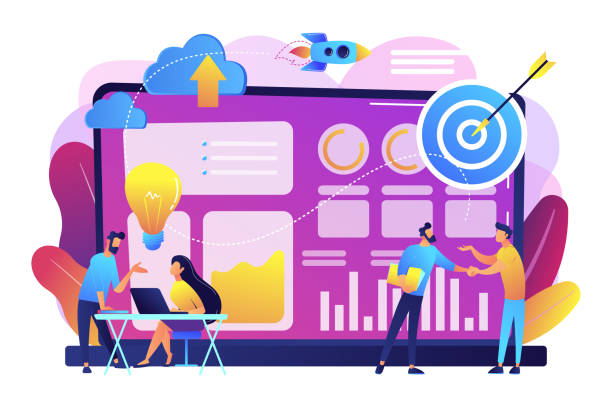
One of the most fundamental steps in achieving fast website design is choosing appropriate hosting and utilizing a CDN.
Hosting selection has a direct and significant impact on your website’s loading speed and stability.
Hosting types include shared hosting, VPS (Virtual Private Server), and dedicated server.
Shared hosting is cheaper, but its resources are divided among multiple websites, which can lead to slowness.
VPS and dedicated servers provide more resources and are more suitable for high-traffic websites.
The server’s geographical location also matters; if most of your users are in Iran, choosing hosting with internal servers or servers close to Iran can reduce ping time and improve access speed.
Also, attention to bandwidth, disk type (SSD offers much higher speed), and technical support for hosting are key points.
Alongside hosting, the use of a Content Delivery Network (CDN) is highly recommended for fast website design.
A CDN is a system of distributed servers worldwide that stores your website’s static content (such as images, CSS, and JavaScript) at various points.
When a user visits your website, content is delivered to them from the closest CDN server, which drastically reduces loading time and offloads your main server.
This is crucial, especially for websites with global audiences or high traffic.
Renowned brands like Cloudflare, Akamai, and Google Cloud CDN offer distinct services in this area.
Investing in strong hosting and a CDN provides the foundation for a fast-loading website.
| Hosting Type | Advantages | Disadvantages | Suitable for |
|---|---|---|---|
| Shared Hosting | Cheap, easy setup | Shared resources, variable speed, less security | Small and new websites |
| Virtual Private Server (VPS) | Dedicated resources, high flexibility, more security | Requires technical knowledge, more expensive than shared | Medium-sized websites with growing traffic |
| Dedicated Server | High performance, full control, maximum security | Very expensive, requires high technical knowledge | Large websites with very high traffic |
Optimizing Images and Media for Greater Speed

One of the biggest factors slowing down websites is the large size of images and media files.
In the pursuit of a fast website design, image optimization is a crucial and often overlooked step.
High-quality images, if not properly compressed and optimized, can be hundreds of kilobytes or even megabytes in size, drastically increasing page loading time.
First, ensure that images are uploaded with correct dimensions.
There is no need to upload an image with a width of 4000 pixels to display it in an area with a width of 800 pixels.
Use image editing software or online tools to resize images before uploading.
Next, compressing images without significant loss of quality is crucial.
Image formats like WebP or AVIF are modern options that offer better compression than JPEG and PNG, and can significantly reduce file size.
Online tools and WordPress plugins (such as Smush, EWWW Image Optimizer) can automatically compress your images.
Additionally, using “Lazy Load” for images is highly recommended.
With this feature, images only load when the user scrolls to the relevant section of the page.
This helps reduce the initial page load and improves the user experience.
In addition to images, videos can also impose a heavy load on the website.
It’s best not to upload videos directly to your server.
Instead, use platforms like YouTube or Vimeo and embed them into your website.
This offloads video loading to these platforms’ powerful servers, keeping your website faster.
By following these tips, you will take a significant step towards optimizing site speed and providing a smooth user experience.
Don’t have a corporate website yet and missing out on online opportunities? With professional corporate website design by Rasaweb,
✅ Double your business credibility
✅ Attract new customers
⚡ Free consultation for your corporate website!
Code Optimization (HTML, CSS, JavaScript) for High Speed

After optimizing infrastructure and media, it’s time to clean and optimize website code, which plays a significant role in fast website design.
HTML, CSS, and JavaScript codes, if not managed properly, can add significant volume to the page and increase browser processing time.
The first step is “Minification” or code minification.
This process involves removing unnecessary characters such as spaces, newlines, and comments from code files.
This reduces file sizes and speeds up their transfer time from the server to the user’s browser.
Various online tools and plugins are available for this purpose, performing this process automatically.
The second important step is file concatenation.
Instead of having multiple separate CSS and JavaScript files, each requiring a separate HTTP request, you can combine them into one or more larger files.
This reduces the number of requests to the server and helps with faster loading.
However, a balance must be maintained so that the concatenated files do not become excessively large.
The next topic is browser caching.
By setting appropriate HTTP headers, you can instruct the user’s browser to store certain files (such as CSS, JavaScript, images) in its cache for a specified period.
This ensures that on subsequent visits to your website, these files are not downloaded again from the server, making page loading much faster.
Finally, the order of resource loading is also crucial.
CSS files should be placed at the beginning of the <head> section so that styles are applied as early as possible, preventing “Flash of Unstyled Content” (FOUC).
JavaScript files, especially those not essential for initial page display, should be loaded using async or defer attributes or placed at the end of the <body> section to prevent their loading from blocking the rendering of other content.
These specialized measures play an important role in achieving high website speed and are vital for a fast website design.
The Role of User Experience (UX) in Fast Websites

When it comes to fast website design, the focus is usually on technical aspects such as hosting, coding, and image optimization.
However, the vital role of User Experience (UX) should not be overlooked.
A good UX can enhance the user’s experience even with a slight loading delay, and truly shine on a fast website.
UX is not limited to the site’s aesthetic appeal but also concerns how the user interacts with the site, the simplicity of navigation, and obtaining needed information with minimal effort.
One important aspect of UX that aids perceived speed is the use of visual feedback.
For example, displaying a loading animation, a Skeleton Screen, or a content preview while the rest of the information loads can give the user the impression that the site is working, preventing premature abandonment.
These techniques do not reduce actual loading time but reduce the user’s perceived waiting time, which is as important as actual speed.
Furthermore, an optimized and uncluttered User Interface (UI) design helps the user achieve their goal faster.
Clear menus, distinct Call-to-Action buttons, and well-structured content all contribute to faster information retrieval and task completion.
Responsive Design, which optimizes the site for various devices (mobile, tablet, desktop), is not only crucial for SEO but also significantly improves user experience, as users access your site from any device and expect a fast-loading and optimized website.
Ultimately, UX is a powerful complementary layer for fast website design that can guarantee a website’s success.
Tools and Metrics for Measuring Website Speed

To ensure that your efforts towards fast website design have been fruitful, you need accurate tools to measure and monitor website performance.
These tools not only help you gauge your site’s current speed but also identify weaknesses and optimization opportunities.
One of the most well-known and widely used tools is Google PageSpeed Insights.
This tool, provided by Google, evaluates your site’s speed for mobile and desktop based on Core Web Vitals (including Largest Contentful Paint – LCP, First Input Delay – FID, and Cumulative Layout Shift – CLS) and offers suggestions for improvement.
GTmetrix is also a powerful tool that analyzes your site’s performance across various metrics such as Full Load Time, Time to First Byte (TTFB), and page structure.
This tool provides more details about the performance of each page component (e.g., images, CSS, JS) and their impact on speed, helping you precisely identify which sections need optimization.
Pingdom Tools is another tool that examines site speed from various global locations and provides a comprehensive report on the loading times of different page components.
This tool is very useful for checking site performance from the perspective of users in different geographical regions.
Key metrics you should pay attention to include: Full Load Time, First Contentful Paint (FCP) which indicates when the first content becomes visible to the user, and Time to Interactive (TTI) which shows the time required for the page to become fully interactive with the user.
Regular monitoring of these metrics and using the above tools will help you continuously maintain high website speed and always stay a step ahead in the journey of fast website design.
| Metric | Description | Importance |
|---|---|---|
| Largest Contentful Paint (LCP) | Time to load the largest visible content element | Indicates initial loading speed and visual experience |
| First Input Delay (FID) | Delay time for the user’s first interaction with the page | Importance for site responsiveness and interactivity |
| Cumulative Layout Shift (CLS) | Visual stability of content during loading | Prevents sudden and annoying layout shifts |
| Time to Interactive (TTI) | Time required for the page to become fully interactive | Indicates when the user can interact with the site |
| First Contentful Paint (FCP) | Time until the first content is displayed to the user | Indicates initial speed of visual feedback |
Common Mistakes That Slow Down Your Website Speed
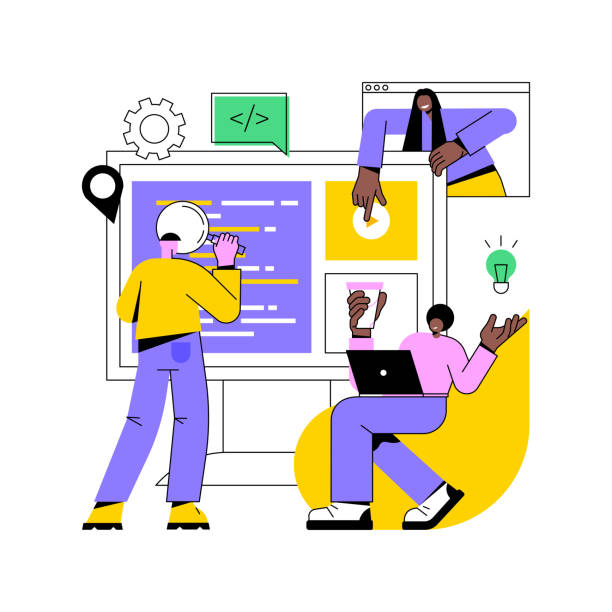
In the journey to achieve fast website design, avoiding common mistakes can be as important as implementing best practices.
One of the biggest errors is neglecting image and video optimization.
Many designers and developers directly upload media files without proper compression and resizing, which severely impacts page loading time.
This mistake alone can be the primary cause of slowness for many websites.
Another mistake is excessive use of add-ons and plugins, especially on platforms like WordPress.
Each new plugin adds extra code and new HTTP requests to the site, which can impose a heavy load on the server and disrupt performance.
Using unreliable or outdated plugins that are not optimized worsens the situation.
Always evaluate the necessity of any plugin before installation and choose optimized and lightweight versions.
Lack of proper caching is also a major mistake.
Without browser-side or server-side caching, the user’s browser is forced to re-download all site resources on every visit, which drastically increases loading time.
Implementing a strong caching system can have a significant impact on high website speed.
Unoptimized coding, including the use of heavy, repetitive, or unnecessary CSS and JavaScript codes, and the lack of compression and concatenation of code files, are also common reasons for slow websites.
Not using a CDN for content delivery to users in different geographical locations can lead to significant delays for websites with global audiences.
Finally, choosing cheap and low-quality hosting, often as an attempt to save costs, leads to performance issues and financial losses in the long run.
Avoiding these mistakes strengthens the foundations of a fast and efficient website design.
Does your company website perform as your brand deserves? In today’s competitive world, your website is your most important online tool. Rasaweb, specializing in professional corporate website design, helps you to:
✅ Build credibility and customer trust
✅ Convert website visitors into customers
⚡ Get a free consultation!
Case Studies and Success Stories in Website Speed Improvement

To gain a deeper understanding of the impact of fast website design, a look at real case studies can be inspiring.
Many companies have seen significant increases in conversion rates, customer satisfaction, and SEO rankings by optimizing their website speed.
For example, one of the e-commerce giants, Amazon, discovered years ago that even a 100-millisecond delay in page loading could lead to a 1% loss in sales.
This analysis prompted Amazon to invest heavily in optimizing its website’s performance and become one of the fastest online shopping platforms.
In another example, Google, a pioneer in web speed itself, has conducted extensive research showing how sensitive users are to speed.
They reported that an increase of just 0.5 seconds in page loading time can lead to a 20% decrease in traffic.
These results have inspired many websites to improve their high website speed.
Another famous case study involves the BBC company.
By reducing their website’s loading time by just 1 second, this news organization saw a 10% increase in new users.
These numbers clearly demonstrate how seemingly small improvements in speed can lead to significant results in attracting and retaining an audience.
Furthermore, many smaller blogs and websites have reported that by implementing site speed optimization techniques, such as image compression, CDN usage, and code improvement, they have not only improved their SEO ranking but also significantly reduced their Bounce Rate.
These success stories attest to the fact that fast website design is a profitable and vital investment for any online business.
Future Trends in Website Speed Optimization

The web world is constantly evolving, and with it, trends in fast website design and speed optimization also change.
In the future, we will see a greater focus on technologies that make the user experience even smoother and faster.
One of the most important future trends is “Progressive Web Apps” (PWAs).
PWAs offer a combination of the best features of web and mobile applications; they can be installed on the phone’s home screen, work offline, and provide a very fast and seamless user experience, directly impacting high website speed.
“Edge Computing” is also an important trend.
By moving data processing closer to the user (the edge of the network) instead of sending it to a central server, latency can be drastically reduced.
This technology can speed up content delivery and improve website responsiveness.
Furthermore, advancements in image and video compression will continue.
New formats like AVIF, which offer better compression than WebP, will become more widely adopted, helping to reduce file sizes.
Increased use of Artificial Intelligence (AI) and Machine Learning (ML) for automatic website optimization is also foreseeable.
These technologies can intelligently analyze user behavior patterns and dynamically preload content or optimize resources.
Finally, the focus on Core Web Vitals and other performance metrics introduced by search engines like Google will continue.
Web developers and designers must continuously monitor these metrics and optimize their websites based on them to maintain their position in future competition and ensure a fast website design.
Frequently Asked Questions
| No. | Question | Answer |
|---|---|---|
| 1 | What does fast website design mean? | Fast website design means optimizing the website’s design and development processes so that the final result (the website) is ready for operation in the shortest possible time, while maintaining quality and efficiency. This includes using efficient tools, templates, and techniques. |
| 2 | Why is speed important in website design? | Speed is important in website design because clients usually have an urgent need for an online presence. Also, longer projects can be more costly and delay business opportunities. Faster website delivery contributes to client satisfaction and competitive advantage. |
| 3 | What tools help with fast website design? | Content Management Systems (CMS) like WordPress, Joomla, or Drupal, using CSS frameworks like Bootstrap or Tailwind CSS, page builders like Elementor or Visual Composer, and Rapid Application Development (RAD) tools help with fast design. |
| 4 | Does using pre-made templates affect fast design? | Yes, using pre-made and standard templates has a very significant impact on fast design. These templates are pre-designed and only require customization of content, color schemes, and images, which drastically reduces development time. |
| 5 | What is the role of CMS (Content Management System) in fast website design? | CMSs play a key role in accelerating the website design and development process due to offering a graphical user interface, not requiring deep coding for most operations, the availability of plugins and pre-made templates, and easy content editing capabilities. |
| 6 | Does high design speed reduce the final quality of the website? | Not necessarily. If standard and optimized methods, tools, and templates are used, a high-quality website can be designed in a short time. The knowledge and experience of the design team are also very effective in maintaining quality. |
| 7 | What tips are important for speeding up the client communication process in website design? | Having a clear and defined process for requirements gathering, using standard forms for content submission, setting realistic deadlines, and holding focused and efficient meetings can expedite client communication. |
| 8 | What effect does image optimization have on website loading speed after design? | Image optimization (volume compression, using appropriate formats like WebP) reduces the overall size of website pages. This reduction helps browsers download and display pages faster, improving user experience. |
| 9 | Is suitable hosting effective in the final speed of the website after design? | Yes, high-quality hosting, powerful servers, sufficient resources, and adequate bandwidth play a very important role in website loading speed after design. Even an optimized website will perform slowly on weak hosting. |
| 10 | For which types of businesses is fast website design more suitable? | Fast website design is most suitable for small and medium-sized businesses, startups, nascent online stores, bloggers, or individuals who need an immediate and cost-effective online presence. This method allows them to enter the market faster and get feedback. |
And other services of Rasa Web Advertising Agency in the field of advertising
Smart Customer Journey Map: Designed for businesses seeking online growth through SEO-driven content strategy.
Smart Custom Software: A combination of creativity and technology to increase click-through rates by using real data.
Smart UI/UX: A fast and efficient solution for customer attraction focusing on appealing user interface design.
Smart Customer Journey Map: A combination of creativity and technology for campaign management through custom programming.
Smart SEO: An innovative service to increase website traffic through SEO-driven content strategy.
And over hundreds of other services in internet advertising, advertising consultation, and organizational solutions
Internet Advertising | Advertising Strategy | Advertorial
Resources
Increasing Site Speed and Its Impact on SEO
How Fast Website Design Improves User Experience?
10 Solutions to Increase Website Loading Speed
The Importance of Responsive Design Alongside Site Speed
? Are you looking to elevate your business in the digital world? Rasaweb Afarin, specializing in responsive website design, SEO, and content marketing, offers innovative solutions for your online growth and prominence.
📍 Tehran, Mirdamad Street, next to Bank Markazi, Kazeroun Jonoubi Alley, Ramin Alley, No. 6

